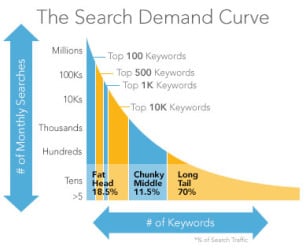The Secret Behind Long Tail Keywords: Using Long Tail Keywords for Better Traffic and ROI
Keywords, along with compelling and unique content, are still the foundation of any successful search engine marketing campaign. Whether you’re running an organic or paid campaign, having the right keyword focus will determine the quality of traffic generated. While everyone’s first instinct is to dive into the most popular and highly searched keywords, that may not always be the best strategy. In fact, using long tail keywords, generally defined as search queries containing at least three or more words, can make the biggest difference in the quality of traffic you attract.
Not quite sure how to differentiate between short tail and long tail keywords? Here’s a simple example.
Short tail keyword: digital camera
Long tail keyword: Canon Rebel T3i Digital SLR Camera
Here are a few reasons why you may want to consider adding long tail keywords to your strategy.
Competition
The biggest allure to short tail keywords is the potential for visibility based on the search volume of a particular keyword. In our example, we can see that the short tail keyword delivers over 726 million results while our long tail keyword only delivered 1.9 million; that’s barely a quarter of a percent in comparison. Like any marketing initiative, the more competition, the harder it is to penetrate and the more costly. Including long tail keywords in your strategy reduces the amount of competition and yields better results.
Search Volume
It may be logical to think that shorter keywords deliver the most search traffic. However, the statistics prove this wrong. The search demand curve, shown below, illustrates both competition and search traffic generated by keyword length.
While the top 100 keywords bring in about 5% of search traffic, long tail keywords generate approximately 70% of all search traffic.

Although higher search volume may sound like the better strategy, using a comprehensive list of long tail keywords can result in a higher amount of traffic to your site.
Cost
Keeping budgets in check is always important. The most obvious difference between using short tail and long tail keywords in campaigns is cost. When running a PPC campaign, generic, short tail keywords are much more costly than long tail keywords. The difference can be enormous – a few cents per click to close to a hundred dollars per click. While there is no direct cost associated with optimizing your site for organic searches, the higher the competition, the more content, the more activity and the more you’ll have to work to achieve any type of visibility for such keywords. This, of course, translates into higher costs.
Traffic Quality & Click Through Rates
For the most part we tend to agree that more is better. While more traffic sounds great, it’s important to distinguish between quality traffic and irrelevant traffic. Traditionally, users who use long tail keywords as search queries are further along the buying cycle and are much more qualified for your particular products or services. Attracting traffic from visitors who already know what they are looking for will result in better click through rates from your ads or organic search results, on top of being better prospects.
Conversion Rates
This is by far one of the best benefits of using long- tail keywords in your marketing campaigns. Since users with highly, specific search queries already have in mind what they want, there is no need to try and convince them of what they want or sell them anything because they already know. Users who search using long tail keywords in their searches are more likely to buy if the price is right.
Short or Long?
On most levels long tail keywords outperform generic, short tail keywords in key performance metrics. While this doesn’t mean a campaign should exclude short tail keywords, it does mean that a good long tail keyword strategy should be in place for any and all of your search campaigns. Creating a long tail keyword strategy is no easy task. It will take time and effort, but doing so it can provide a better way to connect to your target audience by offering them specific and targeted ads or content to meet their needs.



